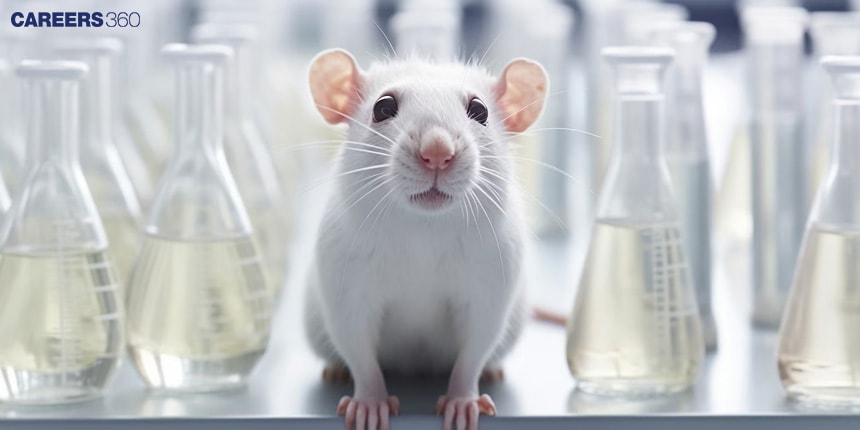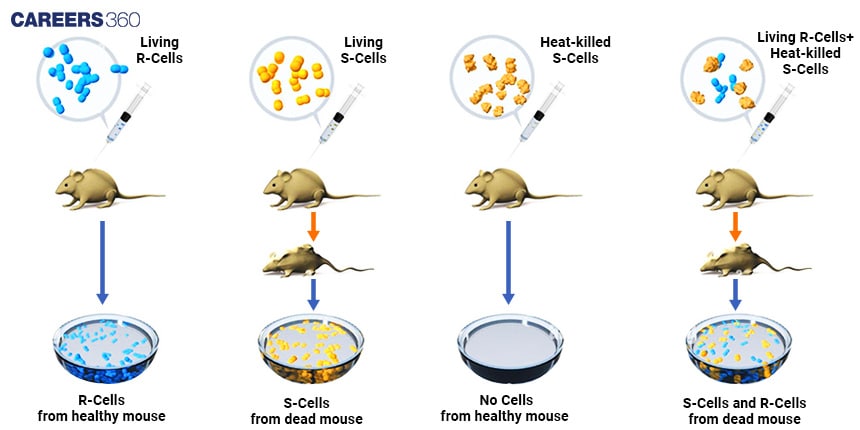Griffith Experiment and Transforming Principle: Introduction, Impacts and Diagram
History Of The Experiment
The Griffith Experiment took place in 1928 when Frederick Griffith conducted a groundbreaking research study, the very first which suggested that genetic information could be transferred between organisms. This experiment was very crucial in the field of genetics, as it gave a concept of the "Transforming Principle" after which DNA was identified as the genetic material. This proved the fact that a factor obtained from dead bacteria could genetically transform the living bacteria and opened the doors for future discoveries within molecular biology.
Latest: NEET 2024 Paper Analysis and Answer Key
Don't Miss: Most scoring concepts for NEET | NEET papers with solutions
New: NEET Syllabus 2025 for Physics, Chemistry, Biology
NEET Important PYQ & Solutions: Physics | Chemistry | Biology | NEET PYQ's (2015-24)

Griffith's Experiment
The central focus of Griffith's experiment was based on locating the reason why particular strains of bacteria were causing pneumonia, whereas other strains were benign. In the current scenario, he was attempting to find out why certain strains of Streptococcus pneumoniae were causing diseases while others were non-pathogenic.
The Basic Setup For The Experiment
Griffith inoculated mice with two strains of Streptococcus pneumoniae: the virulent S strain, exhibiting a smooth colony morphology due to a polysaccharide capsule, and the non-virulent R strain, exhibiting a rough colony morphology due to the absence of this capsule.
Kinds Of Bacterial Strains Utilised
S Strain (virulent): The capsule is made of a polysaccharide, and that is what protects the S strain cell from the host immune system, making it pathogenic.
R Strain (non-virulent): It is non-pathogenic without the capsule, making it remain weak against the host immune system.
Step-By-Step Procedure
1. Injection of Live S Strain into Mice: The mice that were injected with live S strain bacteria succumbed to the disease of pneumonia, and live S strain bacteria were isolated from their bodies.
2. Injection of Live R Strain into Mice: Mice injected with live R strain bacteria survived, and no bacteria could be isolated from their bodies.
3. Injection of Heat-Killed S Strain into Mice: Mice injected with heat-killed S strain bacteria survived, indicating that the heat-killed bacteria were not virulent.
4. Injection of a Mixture of Heat-Killed S Strain and Live R Strain into Mice: Mice injected with this mixture died of pneumonia, and live S strain bacteria were isolated from their bodies. This suggested that some "transforming principle" from the heat-killed S strain had converted the R strain into a virulent form.
Results Of Griffith's Experiment
Griffith found an interesting observation during this experiment: when the samples of non-virulent R strain bacteria were mixed with heat-killed S strain bacteria, something happened that transferred the information of the dead S strain bacteria to turn the live R strain bacteria into the virulent S strain. By this transformation, it was discovered that a "transforming principle" was present that carried the genetic information to turn the dead S strain into a live R strain.
Table: Summary Of The Outcomes From Each Experimental Setup
Experimental Setup | Survival of Mice | Bacteria Isolated |
Live S strain injected | No | Live S strain bacteria |
Live R strain injected | Yes | None |
Heat-killed S strain injected | Yes | None |
A mixture of heat-killed S strain and live R strain injected | No | Live S strain bacteria |
Diagram: Griffith Experiment
Given below is the diagrammatic representation of the Griffith Experiment

Recommeneded video for Griffith's Experiment
Conclusion Of Griffith's Experiment
The result that was most important from Griffith's experiment was the finding of the Transforming Principle. He conclusively demonstrated that an extract from dead, harmless S strain bacteria had transformed the remaining sample of non-virulent R strain bacteria into virulent S strain bacteria. This indicated that material which determined virulence was some sort of transmissible genetic material and hinted that heredity might be exhibited on a molecular scale.
DNA As Genetic Material
After the Griffith study, further research aimed to discover the nature of this Transforming Principle. This was followed by work in the 1940s by Oswald Avery, Colin MacLeod, and Maclyn McCarty, further proving that the Transforming Principle is DNA. Their experiments showed that pure DNA derived from S-strain bacteria, even when other cell components were removed, transformed R-strain bacteria into a virulent form. It was this major discovery that informed the world that DNA was the molecule that stored genetic information.
Further work by Hershey and Chase in 1952 on bacteriophages led to the same conclusions regarding DNA as the genetic material. They showed that when infection took place it was the DNA from the phage, not the protein, which entered the bacterial cell and initiated the production of new phages. These two independent experiments thus defined DNA as the universal genetic material and changed our view of biology and heredity forever.
Conclusion
In other words, the Griffith Experiment was indeed one that discovered the presence of the Transforming Principle and laid a foundation for molecular genetics. His work paved the way for the discovery of DNA as the genetic material: indeed, the discovery was made and the course of science and medicine was changed forever. This knowledge of the molecular basis of heredity has since translated into genetic engineering, biotechnology, and understanding genetic diseases. This is the reason Griffith's experiment is one of the most central bases for modern biology.
Frequently Asked Questions (FAQs)
Griffith discovered the Transforming Principle, indicating that a substance could transfer genetic information between bacteria.
This experiment identified DNA as the Transforming Principle, proving that DNA is the material that carries genetic information.
It laid the groundwork for understanding the molecular basis of genetics and paved the way for the discovery of the DNA double helix structure.
Streptococcus pneumoniae strains: the virulent S strain and the non-virulent R strain.
It was the first to suggest that bacteria could transfer genetic information through a "transforming principle," challenging the prevailing beliefs about genetic material at the time.
Also Read
29 Nov'24 09:31 AM
19 Nov'24 09:26 AM
18 Nov'24 06:45 PM
18 Nov'24 09:29 AM
18 Nov'24 09:18 AM
18 Nov'24 09:01 AM
18 Nov'24 08:37 AM
16 Nov'24 03:45 PM